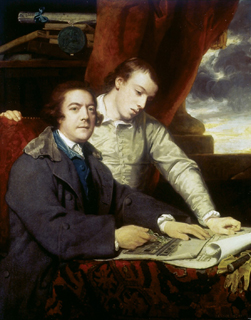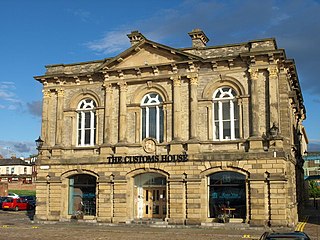
Newcastle upon Tyne, or simply Newcastle, is a city and metropolitan borough in Tyne and Wear, England. It is England's northernmost metropolitan borough, located on the River Tyne's northern bank opposite Gateshead to the south. It is the most populous settlement in the Tyneside conurbation and North East England.

Doncaster is a city in South Yorkshire, England. Named after the River Don, it is the administrative centre of the City of Doncaster metropolitan borough, and is the second largest settlement in South Yorkshire after Sheffield. Noted for its racing and railway history, it is situated in the Don Valley on the western edge of the Humberhead Levels and east of the Pennines. It had a population of 87,455 at the 2021 census, whilst the wider metropolitan borough had a population of 308,100.
The A1, also known as the Great North Road, is the longest numbered road in the United Kingdom, at 410 miles (660 km). It connects London, the capital of England, with Edinburgh, the capital of Scotland. The numbering system for A-roads, devised in the early 1920s, was based around patterns of roads radiating from two hubs at London and Edinburgh. The first number in the system, A1, was given to the most important part of that system: the road from London to Edinburgh, joining the two central points of the system and linking the UK's (then) two mainland capital cities. It passes through or near north London, Hatfield, Welwyn Garden City, Stevenage, Baldock, Letchworth Garden City, Biggleswade, Eaton Socon, Buckden, Peterborough, Stamford, Grantham, Newark-on-Trent, Retford, Doncaster, Pontefract, York, Wetherby, Ripon, Darlington, Durham, Gateshead, Newcastle upon Tyne, Morpeth, Alnwick and Berwick-upon-Tweed.

Yarm, also referred to as Yarm-on-Tees, is a market town and civil parish in the Borough of Stockton-on-Tees, North Yorkshire, England. It is in Teesdale with a town centre on a small meander of the River Tees. To the south-east, it extends to the River Leven, to the south it extends into the Kirklevington.

Tynemouth is a coastal town in the metropolitan borough of North Tyneside, in Tyne and Wear, England. It is located on the north side of the mouth of the River Tyne, hence its name. It is 8 mi (13 km) east-northeast of Newcastle upon Tyne. The medieval Tynemouth Priory and Castle stand on a headland overlooking both the mouth of the river and the North Sea, with the town centre lying immediately west of the headland.

The City of Doncaster is a metropolitan borough with city status in South Yorkshire, England. It is named after its principal settlement, Doncaster, and includes the surrounding suburbs of Doncaster as well as numerous towns and villages. The district has large amounts of countryside; at 219 square miles (570 km2), it is the largest metropolitan borough in England by area.

Newcastle station is a railway station in Newcastle, Tyne and Wear, England, United Kingdom. It is located on the East Coast Main Line, around 268 miles (432 km) north of London King's Cross. It is the primary national rail station serving Newcastle upon Tyne and is an interchange for local services provided by the Tyne and Wear Metro network whose Central Station is situated beneath the national rail station. It is the busiest station in Tyne & Wear, as well as the busiest in North East England.

John Dobson was a 19th-century English neoclassical architect. During his life, he was the most noted architect in Northern England. He designed more than 50 churches and 100 private houses, but he is best known for designing Newcastle railway station and his work with Richard Grainger developing the neoclassical centre of Newcastle. Other notable structures include Nunnykirk Hall, Meldon Park, Mitford Hall, Lilburn Tower, St John the Baptist Church in Otterburn, Northumberland, and Beaufront Castle.

Gibside is an estate in Tyne and Wear, North East England. It is located in the valley of the River Derwent on the border with County Durham, between Rowlands Gill and Burnopfield. The estate is the surviving part of a Georgian landscaped park, primarily created under the ownership of Sir George Bowes (1701–1760) and designed in large part by Stephen Switzer and William Joyce.

James Paine (1717–1789) was an English architect. He worked on number of country houses such as Chatsworth House, Thorndon Hall and Kedleston Hall.

The history of Newcastle upon Tyne dates back almost 2,000 years, during which it has been controlled by the Romans, the Angles and the Norsemen amongst others. Newcastle upon Tyne was originally known by its Roman name Pons Aelius. The name "Newcastle" has been used since the Norman Conquest of England. Due to its prime location on the River Tyne, the town developed greatly during the Middle Ages and it was to play a major role in the Industrial Revolution, being granted city status in 1882. Today, the city is a major retail, commercial and cultural centre.

Doncaster railway station is on the East Coast Main Line serving the city of Doncaster, South Yorkshire, England. It is 155 miles 77 chains (251 km) down the line from London King's Cross and is situated between Retford and York on the main line. It is managed by London North Eastern Railway. It is the second busiest station in South Yorkshire, and the fourth busiest station in Yorkshire & the Humber.

Newcastle Cathedral, formally the Cathedral Church of St Nicholas, is a Church of England cathedral in Newcastle upon Tyne, Tyne and Wear, England. It is the seat of the Bishop of Newcastle and is the mother church of the Diocese of Newcastle.

Gosforth House now known as Brandling House is a Grade II listed building built as a mansion house and now serving as a hospitality and conference centre at Gosforth Park Racecourse, Newcastle upon Tyne, England.

Newcastle Civic Centre is a municipal building in the Haymarket area of Newcastle upon Tyne, England. Designed by George Kenyon, the centre was built for Newcastle City Council in 1967 and formally opened by King Olav V of Norway on 14 November 1968. It is a listed building with Grade II* status and is the joint-eighth tallest building in the city, standing at a total of 200 feet (61 m).

The Customs House is an arts and entertainment venue in the Mill Dam Conservation Area of South Shields, South Tyneside. It opened in July 1864 as a custom house, built to facilitate the import and export of goods at Shields Harbour. Before 1865, both North Shields and South Shields operated as a single customs port following their separation from the Newcastle Customs House in 1848. South Shields was granted customs independence from North Shields in 1865, in part due to the construction of the new custom house building in the town. An extension was added to the building in 1878 to house the Marine Board offices. In the 1970s, the decline of the local shipping industry meant the custom house became derelict. In 1992, the Tyne and Wear Development Corporation led a restoration effort and extension of the building, transforming it into an arts centre.

Scarborough Town Hall, originally St Nicholas House, is a red brick Jacobean Revival mansion in Scarborough, North Yorkshire, England, currently used as a municipal building for the Borough of Scarborough and an events venue. It was built in the 19th century as a home for John Woodall, a prominent local businessman, and then converted and extended for municipal use in 1903. Situated overlooking the South Bay, it is a grade II listed building.
William B. Parnell was an architect active in the 19th century particularly in Newcastle upon Tyne, England. A number of his works on Newcastle Quayside near the then future location of the Tyne Bridge were built following the Great fire of Newcastle and Gateshead in 1854. Noted architect Frank West Rich served as an apprentice under Parnell.

The Mansion House is a historic building in Fernwood Road in Jesmond, Newcastle upon Tyne, a city in Tyne and Wear, in England. The building, which accommodates the official residence of the Lord Mayor of Newcastle upon Tyne, is a locally listed building.



















